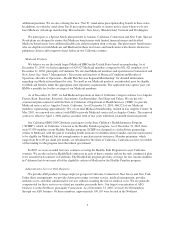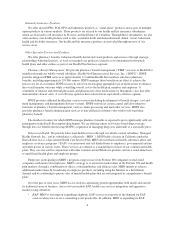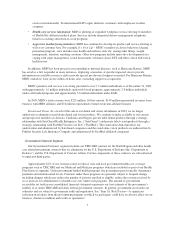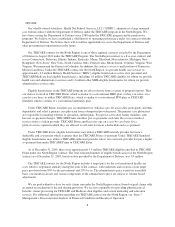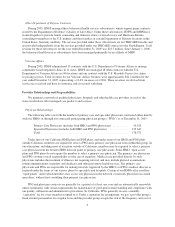Health Net 2005 Annual Report Download - page 17
Download and view the complete annual report
Please find page 17 of the 2005 Health Net annual report below. You can navigate through the pages in the report by either clicking on the pages listed below, or by using the keyword search tool below to find specific information within the annual report.Privacy Regulations. The use of individually identifiable data by our businesses is regulated at the federal,
state and local level. These laws and regulations are changed frequently by legislation or administrative
interpretation. Various state laws address the use and maintenance of individually identifiable health data. Most
are derived from Health Insurance Portability and Accountability Act of 1996 (“HIPAA”) and the privacy
provisions in the federal Gramm-Leach-Bliley Financial Modernization Act of 1999 (the “Gramm-Leach-Bliley
Act”).
HIPAA and the implementing regulations that have been adopted in connection therewith impose
obligations for issuers of health insurance coverage and health benefit plan sponsors relating to the privacy and
security of transmitted protected health information (“PHI”). The regulations, consisting of privacy regulations,
transactions and codeset requirements and security regulations require health plans, clearinghouses and providers
to:
• comply with various requirements and restrictions related to the use, storage and disclosure of PHI,
• adopt rigorous internal procedures to protect PHI,
• create policies related to the privacy of PHI and
• enter into specific written agreements with business associates to whom PHI is disclosed.
The regulations also establish significant criminal penalties and civil sanctions for non-compliance. We are
in compliance with the HIPAA privacy regulations, the requirements relating to transactions and codesets and the
security regulations.
The Gramm-Leach-Bliley Act generally requires insurers to provide customers with notice regarding how
their personal health and financial information is used and the opportunity to “opt out” of certain disclosures
before the insurer shares non-public personal information with a non-affiliated third party. Like HIPAA, this law
sets a “floor” standard, allowing states to adopt more stringent requirements governing privacy protection.
Federal HMO Act. Under the Federal Health Maintenance Organization Act of 1973 (the “HMO Act”),
services to members must be provided substantially on a fixed, prepaid basis without regard to the actual degree
of utilization of services. Premiums established by an HMO may vary from account to account through
composite rate factors and special treatment of certain broad classes of members, and through prospective (but
not retrospective) rating adjustments. Several of our HMOs are federally qualified in certain parts of their
respective service areas under the HMO Act and are therefore subject to the requirements of such act to the
extent federally qualified products are offered and sold.
ERISA. Most employee benefit plans are regulated by the federal government under the Employee
Retirement Income Security Act of 1974, as amended (“ERISA”). Employment-based health coverage is such an
employee benefit plan. ERISA is administered, in large part, by the U.S. Department of Labor (“DOL”). ERISA
contains disclosure requirements for documents that define the benefits and coverage. It also contains a provision
that causes federal law to preempt state law in the regulation and governance of certain benefit plans and
employer groups, including the availability of legal remedies under state law.
Miscellaneous. Our Medicare contracts are subject to regulation by CMS. CMS has the right to audit HMOs
and PPOs operating under Medicare contracts to determine the quality of care being rendered and the degree of
compliance with CMS’ contracts and regulations. Our Medicaid business is also subject to regulation by CMS, as
well as state agencies, and is generally examined on a periodic basis by such state agencies.
California Laws and Regulations
California HMO Regulations. California HMOs, such as HN California and our behavioral health plan,
MHN, are subject to California state regulation, principally by the Department of Managed Health Care
(“DMHC”) under the Knox-Keene Act. Among the areas regulated by the Knox-Keene Act are:
• adequacy of administrative operations,
15


